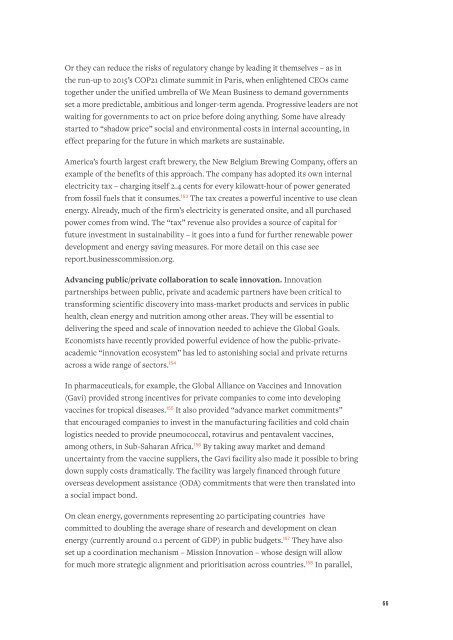BETTER BUSINESS BETTER WORLD
2jxE7K2
2jxE7K2
Create successful ePaper yourself
Turn your PDF publications into a flip-book with our unique Google optimized e-Paper software.
Or they can reduce the risks of regulatory change by leading it themselves – as in<br />
the run-up to 2015’s COP21 climate summit in Paris, when enlightened CEOs came<br />
together under the unified umbrella of We Mean Business to demand governments<br />
set a more predictable, ambitious and longer-term agenda. Progressive leaders are not<br />
waiting for governments to act on price before doing anything. Some have already<br />
started to “shadow price” social and environmental costs in internal accounting, in<br />
effect preparing for the future in which markets are sustainable.<br />
America’s fourth largest craft brewery, the New Belgium Brewing Company, offers an<br />
example of the benefits of this approach. The company has adopted its own internal<br />
electricity tax – charging itself 2.4 cents for every kilowatt-hour of power generated<br />
from fossil fuels that it consumes. 153 The tax creates a powerful incentive to use clean<br />
energy. Already, much of the firm’s electricity is generated onsite, and all purchased<br />
power comes from wind. The “tax” revenue also provides a source of capital for<br />
future investment in sustainability – it goes into a fund for further renewable power<br />
development and energy saving measures. For more detail on this case see<br />
report.businesscommission.org.<br />
Advancing public/private collaboration to scale innovation. Innovation<br />
partnerships between public, private and academic partners have been critical to<br />
transforming scientific discovery into mass-market products and services in public<br />
health, clean energy and nutrition among other areas. They will be essential to<br />
delivering the speed and scale of innovation needed to achieve the Global Goals.<br />
Economists have recently provided powerful evidence of how the public-privateacademic<br />
“innovation ecosystem” has led to astonishing social and private returns<br />
across a wide range of sectors. 154<br />
In pharmaceuticals, for example, the Global Alliance on Vaccines and Innovation<br />
(Gavi) provided strong incentives for private companies to come into developing<br />
vaccines for tropical diseases. 155 It also provided “advance market commitments”<br />
that encouraged companies to invest in the manufacturing facilities and cold chain<br />
logistics needed to provide pneumococcal, rotavirus and pentavalent vaccines,<br />
among others, in Sub-Saharan Africa. 156 By taking away market and demand<br />
uncertainty from the vaccine suppliers, the Gavi facility also made it possible to bring<br />
down supply costs dramatically. The facility was largely financed through future<br />
overseas development assistance (ODA) commitments that were then translated into<br />
a social impact bond.<br />
On clean energy, governments representing 20 participating countries have<br />
committed to doubling the average share of research and development on clean<br />
energy (currently around 0.1 percent of GDP) in public budgets. 157 They have also<br />
set up a coordination mechanism – Mission Innovation – whose design will allow<br />
for much more strategic alignment and prioritisation across countries. 158 In parallel,<br />
66


